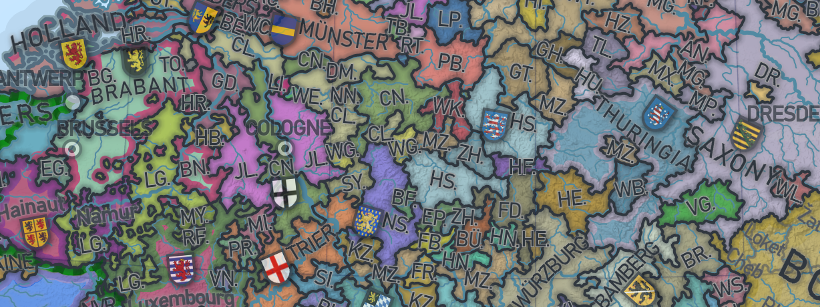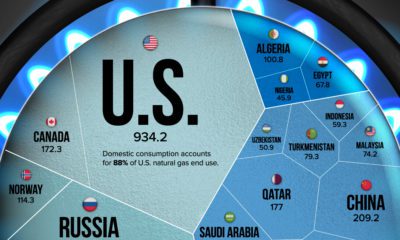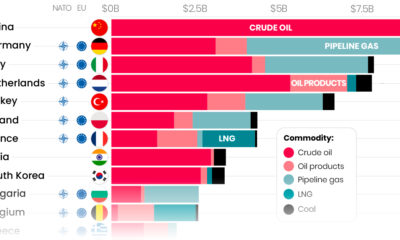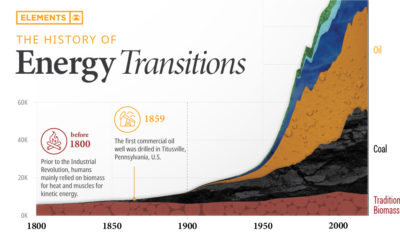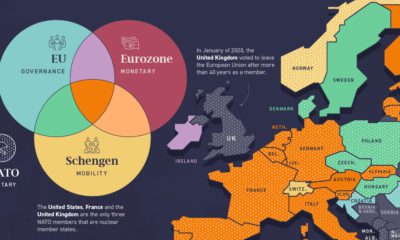This map, shared by Reddit user /ratkatavobratka, provides a historical snapshot of Europe in 1444—a time when European society was made up mostly of independent territories that were governed by landowners rather than a centralized authority. Below, we’ll take a closer look at some key regions on the map, and what was happening in these areas at the time.
Some Context: Why 1444?
Before we dive into the analysis, first thing’s first—what’s so special about the year 1444? It was the year of the Battle of Varna. That’s when the Ottoman army defeated the Hungarians and allowed the Ottoman Empire to expand its reign. It’s considered a pivotal moment for Ottoman expansion into Southern Europe. In fact, this battle is so historically significant, it was chosen as the start date for a popular video game called Europa Universalis IV.
Feudalism in Medieval Europe
One of the most immediately obvious details of this map of medieval Europe is how fragmented Western Europe was at the time. This vast array of independent territories technically made up the Holy Roman Empire (the empire’s borders are highlighted in green on the map). But why was the Holy Roman Empire so fragmented?
The empire was subdivided into individually governed entities at the time. These independent territories were governed by nobility rather than an absolute monarch. This was possible because the empire was run by the feudal system. For the non-history buffs reading this, the feudal system was a socio-political system largely characterized by its lack of public authority. Theoretically, it was meant to have a distinct hierarchy: Between the 1200-1400s, battles between nobles and monarchs were almost constant, and the map shows a time when estates were largely governed by the nobility. However, it’s important to note that in the years following 1444, monarchs gradually began to regain their power. Eventually, governing became more consolidated, and this gradual transition to absolute monarchy marked the early stages of what we now recognize as nation states.
Mighty Lithuania
One very prominent and perhaps surprising section of the map is the Grand Duchy of Lithuania, which today would include large portions of Poland, Belarus, and Ukraine. This snapshot depicts Lithuania at the height of its power, when their territory stretched all the way from the Baltic Sea down to the Black Sea, near Crimea. Over time power ebbs and flows, and today Lithuania is a much more compact nation.
Staying Power
Europe’s borders have shifted constantly over the long history of the continent, but one area has remained remarkably consistent. On the map above, Portugal looks nearly identical to its present day form. This is because the country’s border with Spain–one of the world’s oldest–has barely shifted at all since the 13th century.
Zooming in on the South: The Rise of the Ottoman Empire
While the Holy Roman Empire was highly fragmented, other empires were much more unified.
For instance, the Ottoman Empire had a much more centralized governing system. In 1444, it was ruled by Fatih Sultan Mehmed (which is Turkish for Sultan Mehmed, the Conqueror). During his reign, the Ottoman Empire conquered Constantinople (now known as Istanbul), which had been ruled by the Byzantine Empire for over a thousand years before the Ottoman army seized power.
Because the Byzantine Empire was what was left of the Roman Empire, this takeover also marked the final fall of the Roman Empire.
Maps Freeze Time
Historical maps are fascinating because they provide a snapshot of the world as it once was (but no longer is). As previously mentioned, Europe’s borders were (and still are) constantly changing. And it’s interesting to look back on previous eras to remember how far we’ve come. on Even while political regimes across these countries have changed over time, they’ve largely followed a few different types of governance. Today, every country can ultimately be classified into just nine broad forms of government systems. This map by Truman Du uses information from Wikipedia to map the government systems that rule the world today.
Countries By Type of Government
It’s important to note that this map charts government systems according to each country’s legal framework. Many countries have constitutions stating their de jure or legally recognized system of government, but their de facto or realized form of governance may be quite different. Here is a list of the stated government system of UN member states and observers as of January 2023: Let’s take a closer look at some of these systems.
Monarchies
Brought back into the spotlight after the death of Queen Elizabeth II of England in September 2022, this form of government has a single ruler. They carry titles from king and queen to sultan or emperor, and their government systems can be further divided into three modern types: constitutional, semi-constitutional, and absolute. A constitutional monarchy sees the monarch act as head of state within the parameters of a constitution, giving them little to no real power. For example, King Charles III is the head of 15 Commonwealth nations including Canada and Australia. However, each has their own head of government. On the other hand, a semi-constitutional monarchy lets the monarch or ruling royal family retain substantial political powers, as is the case in Jordan and Morocco. However, their monarchs still rule the country according to a democratic constitution and in concert with other institutions. Finally, an absolute monarchy is most like the monarchies of old, where the ruler has full power over governance, with modern examples including Saudi Arabia and Vatican City.
Republics
Unlike monarchies, the people hold the power in a republic government system, directly electing representatives to form government. Again, there are multiple types of modern republic governments: presidential, semi-presidential, and parliamentary. The presidential republic could be considered a direct progression from monarchies. This system has a strong and independent chief executive with extensive powers when it comes to domestic affairs and foreign policy. An example of this is the United States, where the President is both the head of state and the head of government. In a semi-presidential republic, the president is the head of state and has some executive powers that are independent of the legislature. However, the prime minister (or chancellor or equivalent title) is the head of government, responsible to the legislature along with the cabinet. Russia is a classic example of this type of government. The last type of republic system is parliamentary. In this system, the president is a figurehead, while the head of government holds real power and is validated by and accountable to the parliament. This type of system can be seen in Germany, Italy, and India and is akin to constitutional monarchies. It’s also important to point out that some parliamentary republic systems operate slightly differently. For example in South Africa, the president is both the head of state and government, but is elected directly by the legislature. This leaves them (and their ministries) potentially subject to parliamentary confidence.
One-Party State
Many of the systems above involve multiple political parties vying to rule and govern their respective countries. In a one-party state, also called a single-party state or single-party system, only one political party has the right to form government. All other political parties are either outlawed or only allowed limited participation in elections. In this system, a country’s head of state and head of government can be executive or ceremonial but political power is constitutionally linked to a single political movement. China is the most well-known example of this government system, with the General Secretary of the Communist Party of China ruling as the de facto leader since 1989.
Provisional
The final form of government is a provisional government formed as an interim or transitional government. In this system, an emergency governmental body is created to manage political transitions after the collapse of a government, or when a new state is formed. Often these evolve into fully constitutionalized systems, but sometimes they hold power for longer than expected. Some examples of countries that are considered provisional include Libya, Burkina Faso, and Chad.
